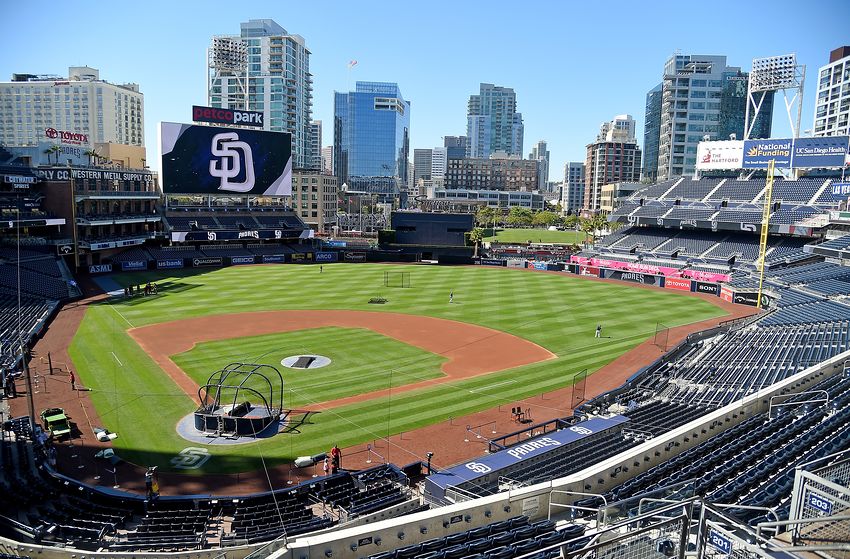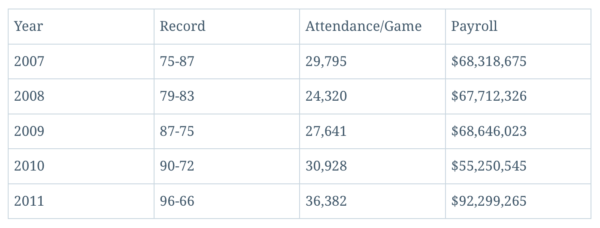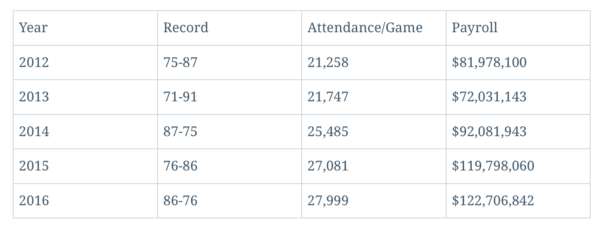Examining the Padres’ Attendance, and Its Relationship to Team Payroll

Photo by Jayne Kamin-Oncea/Getty Images

It’s clear at the moment that the Padres are rebuilding
They are loading up on prospects to gear up for future possible runs at the playoffs and championships.
Naturally, attendance is not going to be great when the team is obviously not making much effort to win this season. The team currently ranks 18th in baseball in drawing an average of 26,882 fans to Petco Park every home game. This number is slightly up from last season’s mark of 26,401 average attendees per game, though it isn’t really a significant enough difference to put much stock in.
Back in 2015, after the trading frenzy A.J. Preller used to try to build a contender with — Attendance was at 30,367 on average at the Padres’ home games. This increase in attendance presumably helped Preller and his staff in affording the high-priced veteran acquisitions they made. It also probably was a part of what funded San Diego’s fruitful 2016 July 2 international signees. If the team had more money to spend following the 2015 season, to what extent could a winning Padres season help fund a higher payroll?
Examining past examples of rebuilding teams that saw attendance increases after they started winning, should provide interesting case studies in answering this question. We want to find out what kind of attendance the Padres might be able to garner, if they started contending in say, 2019 or 2020, for example.
The idea is to see how much the team may be able to increase their payroll, based on the increase in attendance they experienced.
First though, a team has to be identified that could realistically be compared to the Padres and their current rebuilding situation. The key is finding a city with a similar population size to San Diego, where the baseball team was rebuilding for a while, and then started winning in a later season. Additionally, we probably don’t want to pick a city that has a rich baseball tradition or following — As attendance is likely high in those cities even when the team isn’t playing very well. Think Boston, New York, Chicago, and Los Angeles as cities that are either large enough and/or have so much history with the game that attendance at team’s games there is almost always high.
Let’s use the Rangers and the city of Dallas as our case study into how a previously rebuilding team may be able to increase payroll as a result of starting to win more games in a following season. The city sizes of San Diego and Dallas are pretty close, neither team has won the World Series, and they both don’t have particularly rich fan traditions.
Take a look at how the Rangers’ attendance numbers and payroll changed over the years, along with their record in each year:

What’s really interesting is how the team’s attendance and payroll were pretty inconsistent, even though the team began to win more and more with each season during the five year stretch from 2007-11. The jump in payroll from 2010 to 2011 is what catches your eye, and this of course had to do with the fact that the Rangers made it to the World Series in 2010. Even though the increases weren’t always consistent, over time there were significant increases in payroll as the team began to win. Of course along with that trend there was an increase in attendance per game as well. Was the Rangers payroll increase really more related to their 2010 appearance in the World Series above anything else though?
When looking at the increases in payroll by the losers of the World Series in each successive season — The average payroll increase was $12,448,721 million — Much lower than the sudden $37,048,720 million increase the Rangers had in their own payroll following their 2011 loss in the World Series. Clearly, the attendance they had in the 2011 season helped fund a huge increase in the amount of money the team was spending on its players.
Could the 2007 Rangers realistically be compared to the 2018 Padres? The teams play in similar enough markets, and it seems like the Padres could definitely contend in 2020 the way the Rangers did in 2009. With so many talented prospects working their way up the minor league ladder towards San Diego, the Padres are looking like a potential contender in a year or two. Attendance figures for both teams are pretty comparable, so based on the city sizes it would be pretty reasonable to expect the Padres to see the same boost in attendance if they were to start winning like the Rangers did. There’s another team that could be compared to the Padres though, too.
The Mariners present another intriguing case study in attendance and payroll changes once a team begins to win, following losing seasons. Seattle isn’t as close to the size of San Diego as Dallas, but nonetheless there are certainly similarities between the two teams. They are another franchise without a World Series, and are a team that has been mediocre like the Padres all too often. Here’s the same table for the Mariners’ 2012-16 campaigns:

What you see here is a team that was spending similarly to the way the Padres are now, in 2012 and 2013. Then as the team tried to be more competitive, they spent more money on the payroll starting in 2014. The team made a clear effort to try to win, and the fan base rewarded them by increasing the attendance numbers, as seen above. While this table does not extend through the 2018 season, but the Mariners’ payroll has increased to $162.48 million on opening day this year. Despite pretty modest increases in attendance from 2014-18, Seattle added significant money to their payroll. It feels like Mariners fans have likely experienced similar pain to that of the Padres faithful, so Seattle seems like a realistic comparison to make.
If the Padres felt like they were close to winning in a year or two, it looks like they would be able to increase the payroll significantly to improve the team as much as possible. Seeing the team spend $40 million and almost that much in overage taxes during the 2016 July 2 period — Shows that the Padres would have the budget to increase the payroll significantly in the next couple years if they felt like contending was within reach.
With A.J. Preller as the G.M., you never really know what may happen. He’s shown that he’s willing to do anything to rebuild or just flat-out go for it all — So the Padres bidding on top free agents even this winter could be a possibility. If Preller feels like the 2019 free agent class isn’t worth waiting for, he could aggressively pursue free agents in the historically loaded 2018 class. The point is that San Diego can afford to make those kinds of signings, and the likely increases in attendance following that kind of move, would help the team afford a higher payroll.
Once the Padres are ready to win, it looks like ownership is going to be willing to support the team as best it can. Just the fact that the team can actually go out and sign big free agents, and try to sign their best players to extensions — Is something the Padres have never really had the privilege of experiencing. With everyone in the organization finally on board to try to contend, San Diego looks like it will at least give themselves the best chance possible to win a World Series in the years to come.
A sophomore at Willamette University in Oregon, Conrad is majoring in Spanish but is also a writing center assistant for other students at Willamette. He has been a Padres die-hard his whole life and hopes to bring comprehensible statistical analysis to the site.
Perhaps the link is with W-L record. Fans come out to see winning teams, regardless of payroll. So the question becomes to what extent does payroll impact on the field performance?
One would think there’d be a linear relationship, but there is such a thing as spending money unwisely, as we saw in 2015.